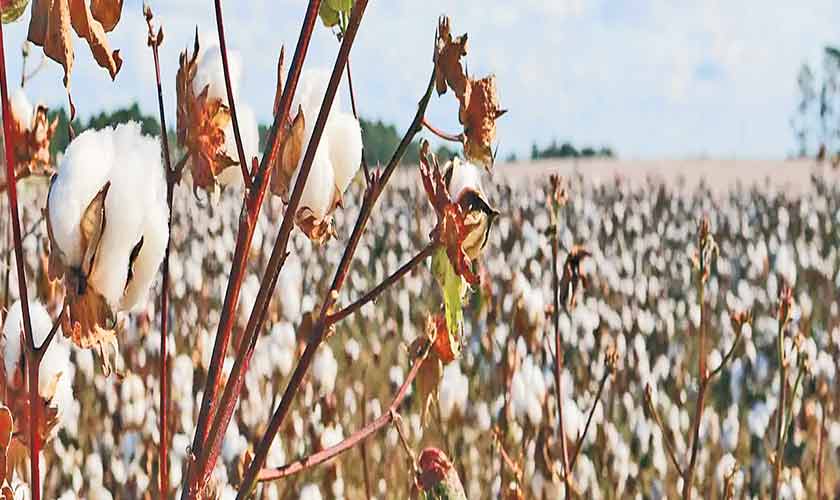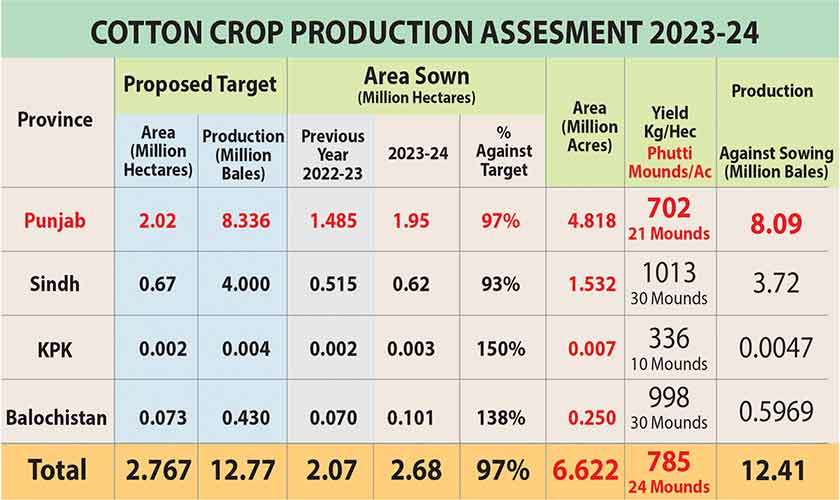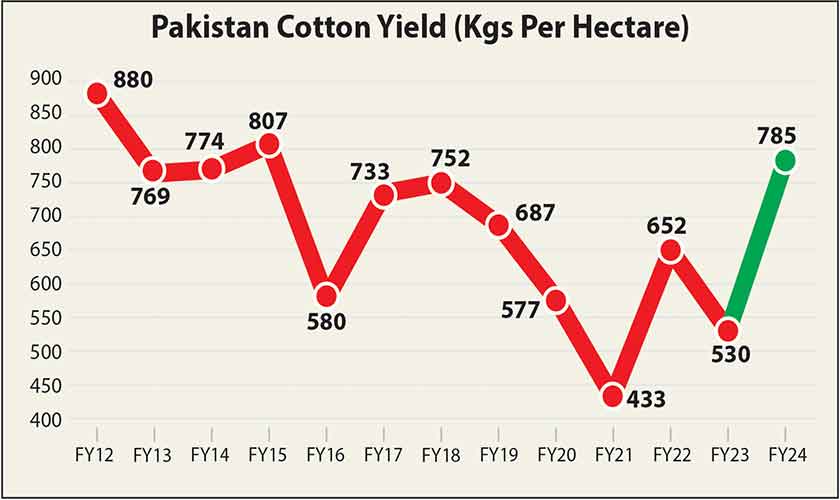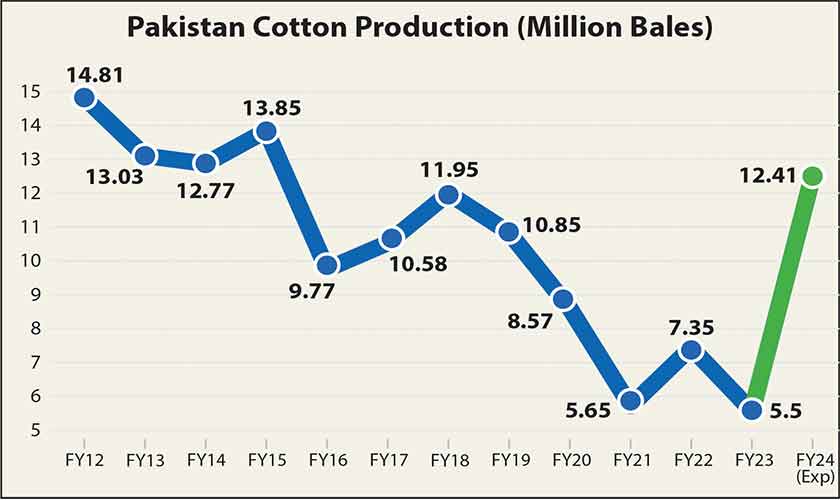Stagnation in Pakistan’s rural economy has been ongoing over the last decade for a multitude of reasons. The lackluster performance of cotton has contributed significantly to this. The cotton sector, which has long been a vital pillar of the country’s rural economy, has faced unprecedented challenges including but not limited to un-approved seeds, substandard pesticides, government apathy etc., leading to adverse effects on the livelihoods of millions of farmers and a larger number of the poorest of the poor women who are seasonally employed for cotton picking.
The cotton industry in Pakistan heavily relies on women cotton pickers working under harsh conditions with low wages, little bargaining power, and facing health hazards. The money earned during the cotton-picking season is steadily dwindling due to the cotton crisis and adding to their dismay. This pushes them further into abject poverty, making their situation even more dire.
Apart from the human angle, cotton is more than just a fiber. It is an “and” crop, providing fiber, linters, and seeds without extra resources. Its byproducts are used in various industries, from cattle feed and oil production to paper and food products. Cotton and its associated products account for 10 percent of the country’s gross domestic product (GDP) and contribute 55 percent to its foreign exchange earnings (Abdul Rehman et al., 2019). As the backbone of Pakistan’s agricultural landscape, cotton cultivation not only provides employment to a significant portion of the rural population (approximately 40 percent) but also contributes substantially to the country’s export revenue and overall economic development. The crisis, characterized by flood damages, declining yields, pest infestations, and unstable global cotton prices, has put the country’s rural communities in a state of distress. The once-thriving cotton fields turned into fields of uncertainty, leaving farmers grappling with financial hardships and pushing them further into poverty.
Unlike the United States, where large corporate farmers dominate production, small farmers grow cotton in Pakistan. Small changes in cotton prices or productivity have significant implications for poverty rates in a region that is consistently facing economic doldrums. A delicate balance exists between cotton productivity and prices, where higher productivity may not necessarily offset the effects of lower prices. A study conducted by researchers from the International Food Policy Research Institute in Benin indicates that reductions in farm-level prices lead to increases in rural poverty (Minot and Daniels, 2002).
The data from Pakistan Bureau of Statistics related to the income inequality in Pakistan shows that urban areas have a higher concentration of wealth in the wealthiest quintile (43.80 percent) compared to rural areas (15.84 percent). As income quintiles rise, average household receipts increase, exacerbating the disparity. In another study data from 480 cotton-growing respondents in Punjab, Pakistan, were analyzed and approximately 67 percent of farm households fell below the poverty line when agricultural income was taken into account. This trend is further fortified by the declining cotton productivity as lower incomes are a direct consequence of productivity.
The data shows fluctuations in cotton yield (kg/ha) over several fiscal years, indicating varying agricultural conditions and practices in the cotton industry. These changes impact farmers’ incomes and the overall economic stability of the region.
Due to cotton’s extensive forward and backward linkages, it holds a crucial role in the advancement of the rural sector in the country. The cotton crisis has disrupted this advancement, leading to a chain reaction of economic repercussions across the country.
Challenges:
The implementation of an 18 percent Goods and Services Tax (GST) on Banola, a byproduct of cottonseed, has had a significant impact on the prices of Phutti (cottonseed). As per the price calculations, the reduction in Banola prices from Rs4,000 per mound to Rs2,200 per mound resulted in a corresponding drop in Phutti prices from Rs8,500 per mound to approximately Rs7,300 per mound. This placed immense financial strain on cotton farmers.
The impact of low cotton rates extends beyond the farmers, rippling through the entire economy. With a large percentage of the rural population relying on cotton farming for their livelihoods, the crisis has led to a rise in unemployment and a decline in household incomes. As cotton prices fall, farmers struggle to cover their production costs, leading to increased debts and economic hardships. Additionally, the reduced income of cotton farmers affects the purchasing power of the rural communities, dampening consumption and further stalling economic activities in the region. The once-thriving rural markets are now subdued, as the financial burden takes a toll on businesses that rely on the prosperous cotton sector.
Beyond the implementation of the GST on Banola, several other factors are contributing to the decline in Phutti prices. The closure of textile mills due to the removal of competitive energy tariffs has resulted in reduced demand for cotton, leading to oversupply in the market and subsequent price decreases. High interest rates have made it financially burdensome for businesses to hold cotton for future consumption, reducing demand and putting downward pressure on Phutti prices. Delayed refunds to the textile industry have also created cash flow constraints for businesses, leading to reduced demand and further affecting Phutti prices.
The high cost associated with maintaining a stock of cotton necessitates a substantial working capital. This means that a significant portion of a business’s funds must be allocated to holding the cotton inventory. As a result, engaging in large-scale buying is not practical or desirable, which puts downward pressure on the farmers supplying the cotton. The need to allocate a considerable percentage of working capital to inventory limits the buying capacity of cotton buyers, leading to reduced demand and potentially lower prices offered to farmers, impacting their income and economic well-being.
Opportunities:
Punjab has embarked on an ambitious plan to revive its cotton industry to lessen the country’s heavy reliance on cotton imports and achieve self-sufficiency in this vital sector. The project aims to reverse the declining cotton production trend by promoting local cultivation and reducing costly imports. This revival can have significant positive effects on the economy, creating jobs, stimulating economic growth, and benefiting supporting industries like textile manufacturing. However, the initiative faces challenges such as ensuring quality seeds, adopting advanced farming techniques, and addressing water scarcity and pest control. Collaborative efforts between the government, research institutions, and farmers are essential for success. If executed effectively, this cotton revival has the potential to make Pakistan a major player in the global cotton market, strengthening the economy and fostering self-reliance.
In addition to the minimum selling price, the Punjab government has taken further steps to stabilize cotton rates and compensate cotton farmers for their efforts. The successful conclusion of the cotton campaign, which witnessed a significant increase in the sowing of over 4.8 million acres of land, marks a major achievement for Punjab’s agriculture sector. The projected yield of around 8 million bales of cotton represents a remarkable 170 percent increase compared to the previous year’s production, indicating the positive impact of the government’s initiatives. By encouraging and assisting cotton farmers during the campaign with timely crop advisories, necessary inputs, and financial support, the government has laid the foundation for a sustainable future for both the textile and agricultural sectors in Pakistan.
Another opportunity for Pakistan’s cotton sector is the establishment of APTMA Cotton Foundation (ACF). It is a pro-poor initiative aiming to revive the cotton crop industry in Pakistan. APTMA has also formed a Cotton Task Force and seeks international collaborations to enhance seed development technologies and bilateral trade. ACF, plans to revolutionize cotton farming by introducing innovative practices, providing technical training to farmers, and improving crop productivity and yield. The project’s goals include introducing improved and advanced genetically modified seeds, restructuring variety approval systems, and implementing measures for emergency cotton research. By achieving these objectives, ACF aims to alleviate poverty, meet domestic cotton demand, reduce import costs, and boost Pakistan’s export-led economic development.
These concerted efforts not only ensure self-sufficiency in cotton production but also reduce the country’s dependence on costly imports, leading to substantial savings in foreign exchange and bolstering the overall economy.
The cotton crop production assessment for 2023-24 also presents an opportunity for Pakistan’s cotton sector, with positive indicators particularly in Punjab and Sindh. Punjab is close to achieving its proposed target with a 97 percent progress rate, which could result in a substantial production of 8.09 million bales. Sindh, though at 93 percent of its target, still expects a production of 3.73 million bales. KPK and Baluchistan have also shown impressive growth, surpassing their targets by 150 percent and 138 percent, respectively. Overall, the total production is estimated to reach 12.41million bales, indicating a potential boost in the cotton industry for the country. This assessment highlights the possibility of enhanced economic prospects, increased textile production, and improved livelihoods for farmers in Pakistan.
Way Forward:
A good cotton crop in Pakistan has the potential to inject substantial money into the rural economy, benefiting the impoverished population the most at the grass root level. Higher yields lead to increased farmer revenues, empowering investments and modernization in agriculture. This success creates more job opportunities, stabilizes wages, and stimulates local businesses, fostering economic growth. Improved incomes enhance educational and healthcare services, laying the foundation for a brighter future in rural communities.
The success of Punjab’s ambitious cotton revival project hinges on strong collaboration and cooperation between the government, research institutions, and farmers. A cohesive approach that involves all stakeholders is essential to effectively address the challenges faced by the cotton sector and ensure the long-term sustainability of the initiative. Research institutions play a crucial role in providing valuable insights and innovative solutions to enhance cotton yields and combat pests effectively. Through collaborative research and development programs, these institutions can contribute to the identification of resilient cotton varieties, advanced farming techniques, and pest management strategies. The government must actively support and fund such research endeavors to equip farmers with the knowledge and tools they need to thrive in a changing agricultural landscape.
To ensure the success of the cotton revival initiative, adequate support, training, and infrastructure are paramount. Farmers need access to modern agricultural practices and technologies that can optimize their cotton cultivation processes. Training programs can empower farmers with the necessary skills and knowledge to implement sustainable farming practices, manage resources efficiently, and improve the quality of their yield. Additionally, investing in agricultural infrastructure, such as irrigation systems and storage facilities, can help mitigate water scarcity issues and post-harvest losses. The government should prioritize allocating resources and funds to upgrade rural infrastructure and establish a robust support system for cotton farmers, ensuring their success and resilience in the face of challenges.
Continuous monitoring and adjustments are critical to maximize the impact of the cotton revival initiatives. Regular assessments of the project’s progress, challenges, and outcomes can identify areas for improvement and optimization. Based on these evaluations, necessary adjustments can be made to ensure that the project remains dynamic and responsive to changing circumstances.
The cotton crisis in Pakistan has deeply affected the rural economy, but with the concerted efforts of the government and its projects, there is hope for a brighter future. The urgency to address this crisis and support cotton growers cannot be overstated, as their livelihoods and the stability of the rural economy hang in the balance.
Through sustainable solutions, ongoing support, and continuous monitoring, the cotton revival project has the potential to not only revitalize the rural economy but also contribute significantly to Pakistan’s self-reliance and economic growth. By addressing challenges and fostering collaboration between all stakeholders, the cotton industry can regain its footing and reclaim its status as a major player in the global market. With dedication, perseverance, and innovation, the cotton revival project can be the catalyst for positive change, bringing prosperity and stability to the lives of farmers and the nation as a whole. As Punjab embraces this transformative endeavor, there is optimism that the cotton sector will thrive once again, fostering a more resilient and prosperous future for Pakistan.
APTMA, being a strong advocate of policies that support the growth and development of the sector, is taking pro-poor initiatives to revive the cotton crop, aiming to uplift Pakistan’s economic outlook and benefit future generations. Its strategic alliance with the Punjab government and establishment of the Cotton Task Force to revamp cotton production and yield is something to look forward to. APTMA has also sought seed development technologies, research affiliations etc., through various avenues. It has also established a Cotton Control Room with a team of dedicated researchers and consultants. Their participation in monthly Cotton Crop Assessment Meetings further strengthens their impactful presence as the largest association.
The government-owned research organizations’ abysmal performance has contributed to the decline of the cotton industry, necessitating a reevaluation of their structure. To rectify both the cotton sector’s issues and boost the economy, it is proposed that the responsibility of running cotton-related research centers may be transferred to APTMA. By entrusting APTMA with this task, there is hope for more effective and industry-tailored research, ensuring a stronger future for Pakistan’s cotton industry and overall economic growth.
The writers are industry officials
https://www.thenews.com.pk/magazine/money-matters/1095562-cotton-crisis




